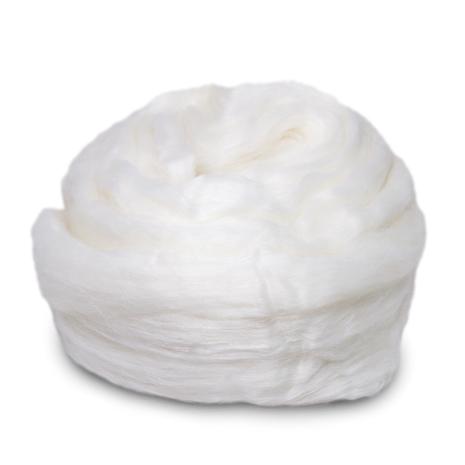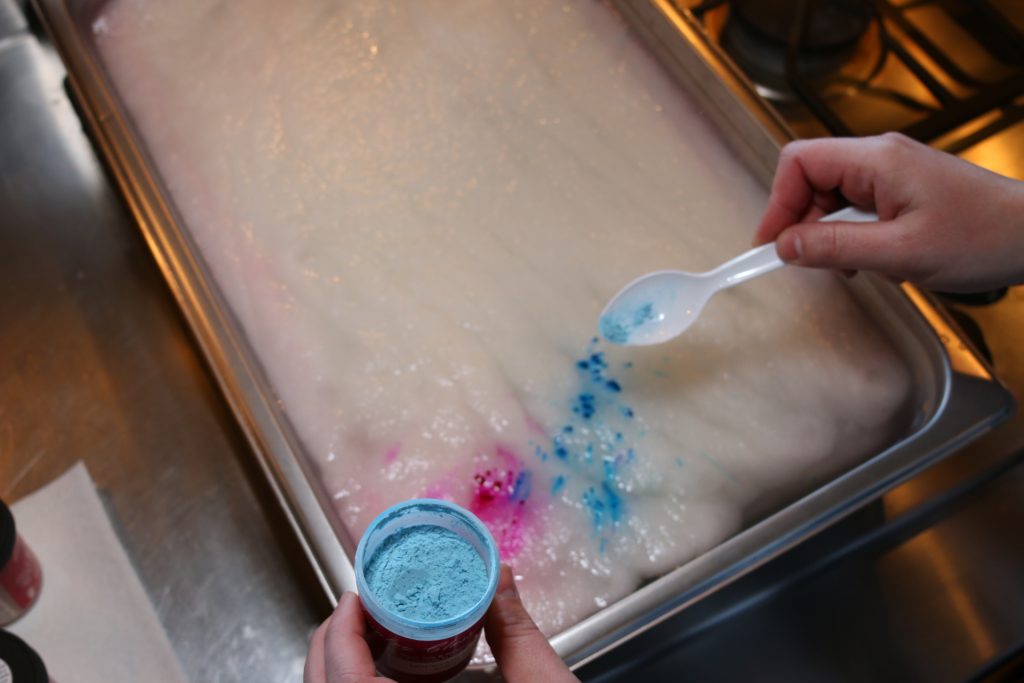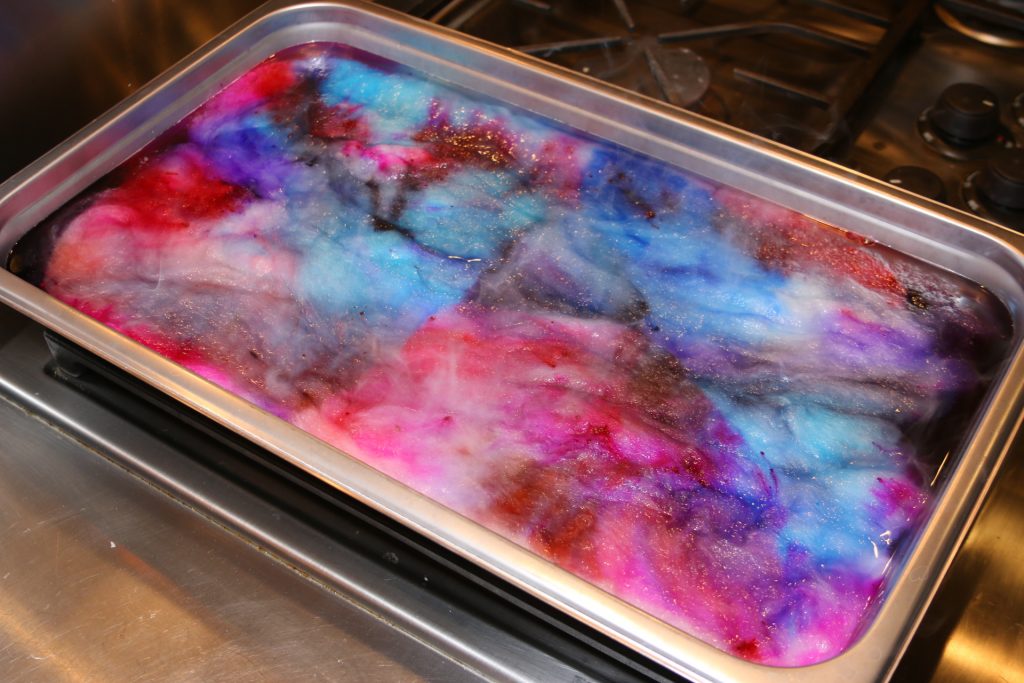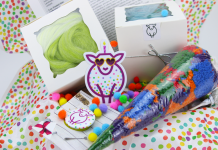Protein Fiber blended with Cellulose Fiber is a match that is a joy to dye, spin, and knit! You can achieve striking results when using protein, cellulose dyes, or both! In our December Fiber Club Box we sent members 3 exclusive, never before seen, undyed 50/50 blends: Milky Mohair, Minty Merino, and Pearly Polwarth! We also included a vibrant and colorful bead mixture and a bead threader with a tutorial on how to spin beads directly into your yarn. We celebrated everything soft and luxurious in December with snow white blends that are cool to the touch. Let’s dive in!
Fiber Breakdown

Milk Protein Fiber is a casein protein made using a process that is similar to viscose, but because it’s a regenerated protein fiber and not a regenerated cellulose fiber, it reacts like wool. This blend is a 50/50 undyed top of Milk Protein Fiber and Kid Mohair. Kid Mohair is made from the hairs of the Angora goat, mohair is durable, warm, extremely lightweight, and lustrous with a soft hand. It is the most resilient natural textile fiber. Kid Mohair possesses the unique feature of natural wicking properties that takes perspiration away from the skin, preventing bacteria build up and odor. The texture of this blend is silky and smooth lending itself nicely to dyeing, spinning, and blending projects. The finished yarn has incredible luster and drape with antibacterial properties. This blend of fiber has superior strength and contain 17 amino acids! With a medium staple length of 2-3 inches and a micron count of approx 22.

Mint Fiber is a very new biodegradable cellulose fiber that is infused with mint powder extracted from peppermint leaves. This blend is a 50/50 undyed top with Superfine 18.5 micron Merino Wool Top and mint fiber. The color is off white with a slight golden tint. The texture is lofty and smooth lending itself nicely to dyeing, spinning, wet and needle felting, and blending projects. The finished yarn has lovely drape and natural cooling and antibacterial properties. This fiber is very lustrous and soft with excellent moisture absorption too.

Pearl Fiber is a very new biodegradable cellulose fiber that is infused with precious pearl powder which contains natural amino acids and trace elements. This blend is a 50/50 undyed top with Polwarth Wool and pearl fiber. The color is white. The texture is lofty and smooth lending itself nicely to dyeing, spinning, wet and needle felting, and blending projects. The finished yarn has loft, natural cooling properties, excellent moisture absorption, and an Ultraviolet protection factor greater than 30! This fiber is lustrous and soft.
WINTER PROJECTS

In Spokane, WA winters are cold and often dreary with the occasional snow day. What better way to brighten up the season than to dye and spin with beads!? That is exactly what I did this month with our Fiber Blends using our no fuss Country Classics Dye on the stovetop. Here’s How:
Step 1: Soak your Fiber Overnight in your dye bath. I used a Food Tray you can get at most stores. Lay your fiber evenly in the vessel and fill with water and a dash of vinegar until the fiber is fully submerged. Let sit for several hours or overnight like I did.

Step 2: Set your stove top to simmer and place vessel on top. Once you see steam it’s time to sprinkle your dye on top.

I used a total of 9 colors sprinkled randomly on the fiber. About 1/2 teaspoon of each.


Step 3: Let the fiber sit in the hot water on the stove top for approx 30 minutes. I only let my fiber sit for about 10 minutes and didn’t achieve the bright colors I originally wanted. Because this blend is 50% cellulose the dye should only stick to the protein fibers making an interesting effect. Once the time is up, dump your water in the sink and rinse the fiber in warm water until the water runs clear, be careful not to agitate the fibers to prevent felting. I used a salad spinner to then spin my roving dry.



Spinning With Beads
When my friend told me that you can spin beads into your yarn as you spin my eyes lit up and I immediately had to try it! To my surprise it was just as hard to do as it sounds. Like with any project, patience is key! I will walk you through the steps to create your very own beaded yarn using our Milky Mohair Fiber Blend, a bead threader, and size 3mm beads.

Step 1: Separate your fiber into two equal parts. You will pre-thread half of the fiber with beads and spin the other half without beads. Split one half into small pieces of fiber. Approx 1/4 of an inch wide and 7 inches long. Load your bead threader with one bead and slip one piece of fiber through the opening.

Make sure your piece of fiber isn’t too thick or it will be hard to thread the bead onto the piece of roving.
Step 2: Pull the fiber through the opening of the bead threader about 2 inches and slide the bead off of the threader and onto the fiber.
 Step 3: Push the bead halfway up the roving until it rests in the center. Now repeat this as many times as you’d like. I created approximately 70 pre-threaded pieces to spin into my yarn using half of the original 3 oz. of fiber.
Step 3: Push the bead halfway up the roving until it rests in the center. Now repeat this as many times as you’d like. I created approximately 70 pre-threaded pieces to spin into my yarn using half of the original 3 oz. of fiber.

 Step 4: Spin the other half of your fiber and set aside on a bobbin.
Step 4: Spin the other half of your fiber and set aside on a bobbin.
Step 5: Attach your first piece of pre-beaded fiber to your leader on another bobbin and spin all of your pre-beaded pieces end to end.
 Step 6: Now comes the tricky part. In order to prevent your beads from sliding all over the place, you will need to break off a piece of the fiber in front of the bead ( before the twist enters ) and place the piece of fiber behind the bead, allowing the twist through to trap the bead in place.
Step 6: Now comes the tricky part. In order to prevent your beads from sliding all over the place, you will need to break off a piece of the fiber in front of the bead ( before the twist enters ) and place the piece of fiber behind the bead, allowing the twist through to trap the bead in place.




Step 7: Repeat this until all your pre-beaded pieces are spun. Now you are ready to ply the beaded single with the un-beaded single! To make this easier I used the Paradise Fibers Lazy Kate!
Since this was my first time, I’ll admit, my skein wasn’t too pretty. With practice I am confident I will soon master beaded yarns! Somehow I managed with some left over un-beaded yarn after plying so I made a mini skein with it that I plan to dye.
The last blend in the box this month was the Minty Merino Fiber. I love the loft of this blend so I decided to spin a dense, chunky, two ply yarn! I am so in love with the results I am afraid to do anything with the yarn. So it shall sit on my desk until I’m ready to dye and knit it 😉

Winter Wonderland
Did you receive our December Box? Share what you decided to do with the fibers in the comment section below! Want to receive curated fiber boxes like this every month? Sign up for our Fiber of The Month Club Today and Join the Discussion on our Ravelry Group! We aim to supply you with the knowledge and Fiber necessary each month to broaden your spinning abilities and help get you out of a creative rut!













